Cottages and castles, apple orchards and oast houses – this lush and historic area in the heart of Kent has been blessed with the best of nature’s bounty.
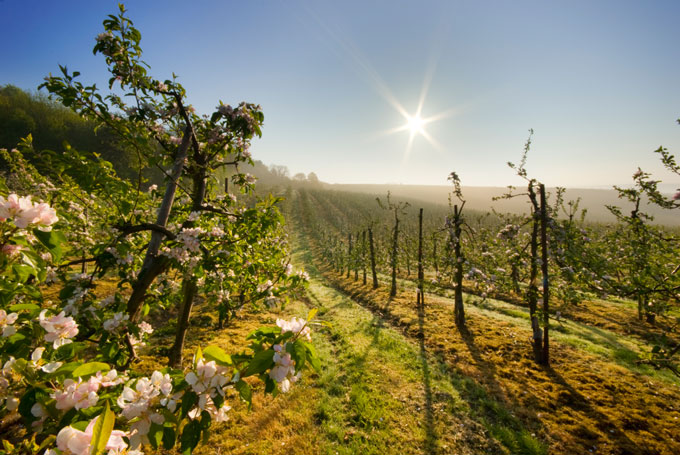
Start a discussion about Kent and the subject of hop picking will certainly arise. The county, originally known as Cantia, is called the Garden of England because of its low rainfall and mild climate, its many orchards and hop gardens. Hop picking was once the annual ‘working holiday’ for Londoners who would travel to Kent to pick the hops, first introduced to Britain by the Romans.
Today, a familiar sight in south-east England is the distinctive cone-shaped oast house, a reminder of Britain’s once thriving beer industry. An oast consisted of three rooms: the kiln, the drying room and the cooling room. The hops were dried in the drying room – just above the kiln, then dragged into the cooling room, before being pressed and baled into packets for despatch to the breweries. However, times change and imported hops now flood the market and oast houses have been converted into exclusive and expensive homes.
In 1991 when The Darling Buds of May burst onto our television screens – and we first heard Pop Larkin utter the word “perfick” – those idyllic rural scenes of Kent in the 1950s evoked memories of life in the good old days. Filmed in and around the village of Pluckley, with its chocolate-box cottages, oast houses and ghostly legends, H E Bates’ classic tale about the Larkin family soon had the public clamouring to see for themselves where they ‘lived’ and Pluckley found itself on the tourist trail.
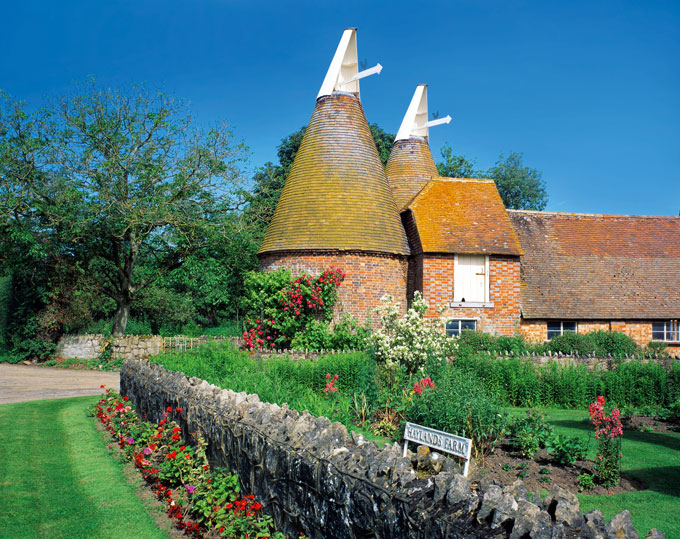
Reputed to be one of the most haunted in England, the village claims at least 12 ghosts, one of which inhabits the Black Horse pub. An interesting feature of this building is the curiously shaped windows. It was through such a window that a member of a local prominent family – the Derrings – escaped from Parliament, during the Civil War. Similarly-shaped windows are now replicated throughout the village.
Another enchanting Kent village is Chilham. Nestling high above the River Stour valley, its narrow steep lanes climb up to emerge into the picturesque village square where, annually on May Day (the first Monday in May), the square is transformed by festivities and market stalls of every variety. At each end of the square, major buildings stand guard: Chilham Castle, owned by prominent businessman and gambler, Stuart Wheeler, who claims he played bridge with Lord Lucan two days before he disappeared, and with Omar Shariff. There is the 15th-century church of St Mary’s where Sir Thomas Becket is believed to be buried. The village is also close to the Pilgrims Way, which leads to Canterbury England’s famous cathedral city of Geoffrey Chaucer’s Canterbury Tales, and now a UNESCO World Heritage Site. Archbishop Thomas Becket was killed here on 29 December 1170, on the altar steps inside the Cathedral.
Chilham is also famous for the Woolpack Inn – complete with 16th-century oak beams, a vast inglenook fireplace and 14 bedrooms, one of which is supposedly haunted by the Grey Lady – and its proximity to the stunning Kent Downs, sheltering the villages of Shottenden and Old Wives Lees.
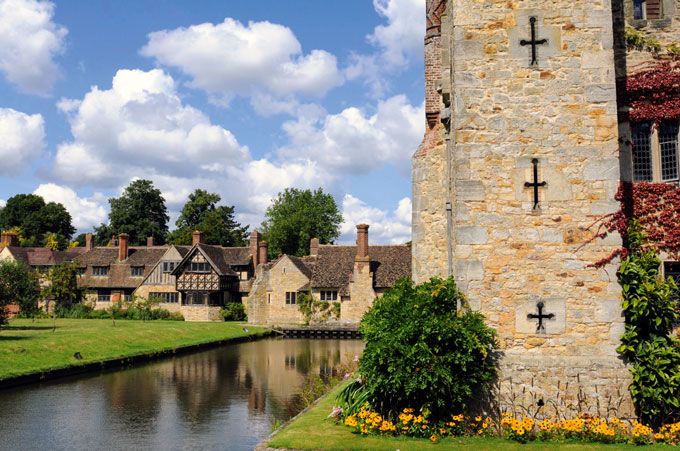
Kent is an ancient land full of charm and legend and Tenterden, which grew from the 14th century around the wool industry, offers the best of all worlds: history, exquisite architecture and excellent shops. All within a typical country town where Georgian buildings share the streets with tall Victorian houses and tiny cottages, brick and stucco sit next to Kent tiles and weatherboard.
Nearby, the hamlet of Small Hythe was once a flourishing shipbuilding port where Henry VIII’s warship The Grand Masters was built. All that has changed and today Small Hythe is more about theatre than shipbuilding, because in 1899, one of England’s finest Shakespearean actors Dame Ellen Terry, purchased Smallhythe Place. She lived in the 16th-century half-timbered house until her death in 1928. Now it is a National Trust-run museum for her unique collection of stage costumes and theatrical memorabilia. In summer, plays are performed in the Rose Gardens or in the thatched Barn Theatre.
Near Royal Tunbridge Wells, with its interesting shops and decorative Pantiles, is Lamberhurst and the romantic Scotney Castle. This ruined 14th-century moated castle is a breathtaking visual treat while the gardens accommodate the rare heather-thatched ice house. In spring, Scotney sits amid the finest display of bluebells in Kent.
Not too far away is Marle Place Gardens at Brenchley. Privately owned, this Wealden garden is ten acres of formal planting as well as woodland and orchards, a haven for wildlife and bees. It features a Victorian gazebo, an Edwardian rockery and a beautiful, walled fragrant garden, which in spring onwards is a joy to the senses. The restored 19th-century gatehouse protects an amazing collection of orchids and the mosaic terrace and ornamental ponds really do have to be seen to be believed. Situated close to Scotney and the magnificent Sissinghurst Castle, Marle Park Gardens and Gallery is one of the seven wonders of the Weald – a group of attractions all close together.
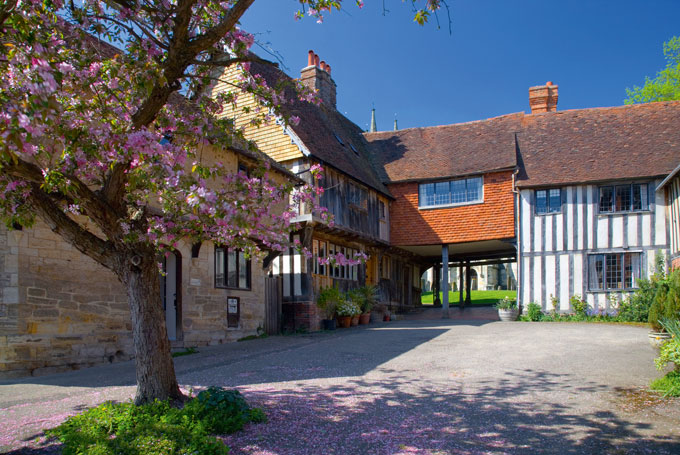
Also off the beaten track is Hever, tucked between Penshurst and Edenbridge. Hever Castle, the childhood home of Anne Boleyn, is where Henry VIII first saw the bewitching Anne. They married in 1533 and she was subsequently executed in May 1536. Anne was, of course, the mother of Elizabeth I. Hever, and its spectacular Italianate gardens, famed for its glorious roses, is open to the public and home to regular events and Tudor exhibitions. You can feast your eyes upon Anne’s gowns, her embroidery, her Bible – and even the bedroom where Henry slept.
Alongside the castle is the parish church of St Peter, where Anne Boleyn’s father Sir Thomas Boleyn is buried. Immediately opposite is the inn bearing Henry’s name. Despite its excellent reputation locally for good food, the Henry VIII Inn achieved notoriety in 1983 as the place where the infamous Brinks Mat bullion robbery was planned. Even the nearby pond was dragged by local police in their hunt for the proceeds.
Wherever you roam in Kent, you will find quintessential English villages – another is Penshurst. Lying between two rivers, it has an ancestral home that has stood for over 600 years. Penshurst Place, a medieval masterpiece has, since 1552, been the seat of the Sidney family including Sir Philip Sidney, Elizabethan poet, courtier and soldier. Elizabeth I was a frequent visitor. Today, his namesake, Philip Sidney, Viscount De L’Isle, continues the guardianship of his magnificent home and gardens. The estate also boasts a famous deer park and nature trail. At Quaintways Tea Rooms on Penshurst’s high street, you can enjoy a delicious cream tea before a short drive through meandering lanes brings you to Chiddingstone. This tiny, one-street village remains so unspoiled that its 16th- and 17th-century houses are frequently used as film and television locations. One house is rumoured to have been home to Catherine Parr, before she became wife number six to Henry VIII. The Castle Inn has been an inn since 1730 – when it was called the Five Bells – and Sunday lunch here is an institution, the locals say. They welcome you into the bar, insisting you go to find the large sandstone Chiding Stone, behind the village school. They will tell you it was here that women were brought to be reprimanded for gossiping or causing a nuisance.
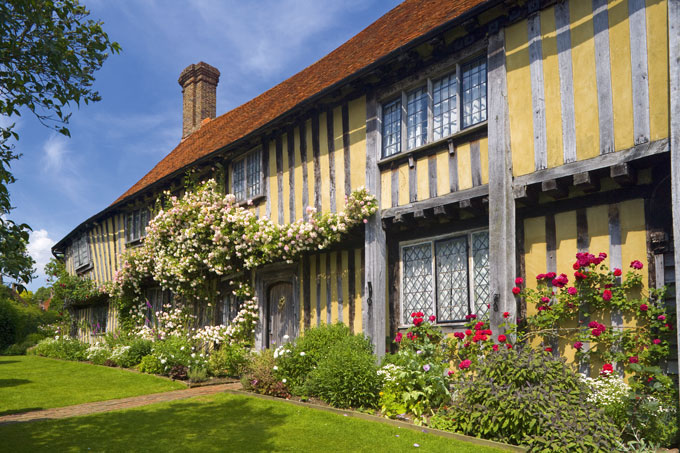
But Kent has more to offer than just pretty villages. Squerryes Court, a 17th-century manor house has been home to the Warde family since 1731, and is surrounded by 20 acres of historic gardens, including a lake and an 18th-century dovecote. In spring, golden daffodils and carpets of bluebells can be seen for miles around, while the herbaceous borders and old roses bloom all summer. Following the Great Storm of 1987, the garden has been replanted in the style of the original garden back in the 1600s and Squerryes’ newest project is to lay woodland walks in the wild garden.
So many have left their mark on this fascinating county, but none more than arguably Kent’s most famous resident – Sir Winston Churchill. His home is not far from Squerryes Court, at Westerham, where a monument to the great man dominates the town green. Upon first seeing Chartwell, he immediately fell in love. The tranquillity captivated him and looking out over the Weald of Kent, many years later, he would say, “I bought Chartwell for that view.”
So how should one describe Kent? Perhaps H E Bates’ hero Pop Larkin would have said it best: perfick!
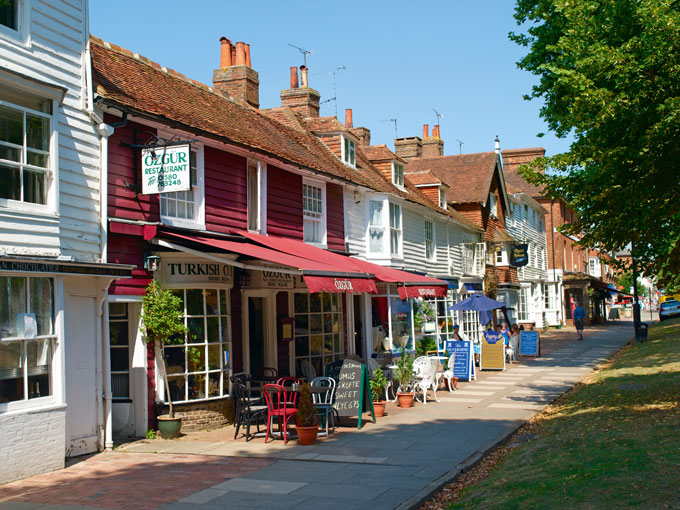
Visit Kent: where to go
Groombridge Place Gardens and Enchanted Forest, Tunbridge Wells. Award-winning gardens combining traditional with ancient woodland. Tel: (01892) 861444.
Ightham Mote (National Trust), Sevenoaks. Outstanding 14th-century moated manor house including a Tudor chapel and gardens with water features. Tel: (01732) 811145.
Queens Inn, Hawkhurst. Elizabeth I often stayed here on her travels through Kent to Rye and the Cinque Ports. Tel: (01580) 753577.
Leeds Castle, near Maidstone. A fairytale castle floating on a lake might make you think you are dreaming but no, this is Leeds Castle, beside the main Maidstone to Ashford road. Tel: (01622) 765400.
Lullingstone Roman Villa (English Heritage), Eynsford. Among the most outstanding Roman villa survivals in Britain, tracing Roman domestic life over three centuries. Tel: (01322) 863467.
Pantiles Papertole, Tunbridge Wells. If you enjoy making your own cards and ornaments, a visit here is a must. Tel: (01892) 618191.
Smallhythe Place (National Trust), Tenterden. Actress Dame Ellen Terry’s 16th-century cottage with a collection of costumes and personal mementoes. Tel: (01580) 762334.
Hever Castle & Gardens, near Edenbridge. The childhood home of Anne Boleyn contains Tudor portraits, tapestries and armour, with glorious gardens to boot. From 1 April to 31 October, the gardens open at 10:30am and the castle at 12 noon. Hever Castle closes at 6pm. Tel: (01732) 865224.
If this taste of Kent has whet your appetite for more, there is a wonderful feature on Hever Castle in the current issue of BRITAIN magazine, available here.





 © 2024
© 2024